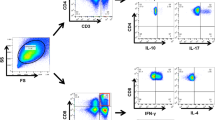Abstract
Soluble HLA class I antigens (sHLA-I),β 2-microglobulin (β 2-μ.) and alanine aminotransferase (ALT) serum levels have been evaluated in 16 patients affected by chronic hepatitis C treated for six months with recombinant interferon-α (rIFN-α, 3 MU three times a week). The predictor role of sHLA-I and ALT modifications with respect to the response to rIFN-α therapy was also evaluated. Six patients responded (group 1), five patients relapsed following an initial response (group 2), and five did not respond to rIFN-α treatment (group 3). The baseline serum levels of sHLA-I andβ 2-μ were significantly higher in all three groups of HCV-positive patients with respect to HCV-negative controls (P<0.05). A significant increase of sHLA-I serum level with respect to baseline value (P<0.001) was observed in group 1 patients after two weeks of rIFN-α treatment. sHLA-I serum level then decreased, although remaining steadily and significantly increased with respect to baseline (P values ranging from 0.05 to 0.01) in the following five months and then returned to baseline one month after the end of rIFN-α administration. No significant variations ofβ 2-μ serum levels were detected throughout the observation period. In group 1 patients ALT serum levels significantly decreased after two weeks of rIFN-α treatment (P<0.001) and then remained in the normal range throughout the observation period. In the other two groups of patients no relevant variations of sHLA-I andβ 2-μ serum levels were found during and after rIFN-α therapy. The modifications of sHLA-I serum levels discriminate, as a single marker, group 1 patients from group 2 and 3 patients after two weeks of rIFN-α treatment (P<0.003). The association of sHLA-I and ALT modifications improves the discriminant power and leads to a complete differentiation of the three groups of patients after four weeks of rIFN-α treatment (P<0.0001). If confirmed in a larger series of patients, these results will provide a useful marker to predict which patients affected by chronic hepatitis C will respond to treatment and will help to avoid their ineffective treatment with an expensive and potentially harmful drug.
Similar content being viewed by others
References
Davis GL, Balart LA, Schiff ER, Lindsay K, Bodenheimer HC Jr, Perrillo RP, Carey W, Jacobson IM, Payne J, Dienstag JL: Treatment of chronic hepatitis C with recombinant interferon alpha. A multicenter randomized, controlled trial. N Engl J Med 321:1501–1506, 1989
Di Bisceglie AM, Martin P, Kassianides C, Lisker-Melman M, Murray L, Waggoner J, Goodman Z, Banks SM, Hoffnagle JH: Recombinant interferon alpha therapy for chronic hepatitis C. A randomized, double-blind, placebo-controlled trial. N Engl J Med 321:1506–1510, 1989
Tiné F, Magrin S, Craxi A, Pagliaro L: Interferon for non-A, non-B chronic hepatitis. A meta-analysis of randomised clinical trials. J Hepatol 13:192–199, 1991
Saracco G, Rosina F, Torrani Cerenzia MR, Lattore V, Chiandussi L, Gallo V, Petrino R, De Micheli AG, Donegani E, Solinas A: A randomized controlled trial of interferon alpha-2b as therapy for chronic non-A, non-B hepatitis. J Hepatol 11:S43-S49, 1990
Marcellin P, Boyer N, Giostra E, Degott C, Courance AM, Degos F, Coppere H, Cales P, Conzigou P, Benhamou JP: Recombinant humanα-interferon in patients with chronic non-A, non-B hepatitis: A multicenter randomized controlled trial from France. Hepatology 13:393–397, 1991
Allison JP, Pellegrino MA, Ferrone S, Callahan GN, Reisfeld RA: Biologic and chemical characterization of HLA antigens in human serum. J Immunol 118:1004–1009, 1977
Dobbe LME, Stam NJ, Neefjes JJ, Giphart MJ: Biochemical complexity of serum HLA class I molecules. Immunogenetics 27:203–210, 1988
Sakaguchi K, Koide N, Takenami T, Matsushima H, Takabatake H, Ferrone S, Tsuji T: Soluble HLA class I antigens in sera of patients with chronic hepatitis. Gastroenterol Jpn 27:206–211, 1992
Comuzio S, Puppo F, Ruzzenenti R, Orlandini A, Grillo F, Brenci S, Lanza L, Scudeletti M, Indiveri F: Simple ELISA method for the evaluation of soluble HLA class I antigens in human serum. J Clin Lab Anal 5:278–283, 1991
Ferrone S, Yamamura M, Grosse-Wilde H, Pouletty P: Summary of serum-soluble HLA class I antigen component.In HLA 1991, Proceedings of the Eleventh International Histocompatibility Workshop and Conference. Oxford, Oxford Science Publications, 1992, pp 1057–1061
Puppo F, Brenci S, Lanza L, Bosco O, Imro MA, Scudeletti M, Indiveri F, Ferrone S: Increased level of serum HLA class I antigens in HIV infection. Correlation with disease progression. Hum Immunol 40:259–266, 1994
Onji M, Kikuchi T, Kumon I, Masumoto T, Nadano S, Kajino K, Horiike N, Ohta Y: Intrahepatic lymphocyte subpopulations and HLA class I antigen expression by hepatocytes in chronic hepatitis C. Hepatogastroenterol 39:340–343, 1992
Brieva JA, Villar LM, Leoro G, Alvarez-Cermeño, Roldàn E, Gonzalez-Porqué P: Soluble HLA class I antigen secretion by normal lymphocytes: relationship with cell activation and effect of interferon-gamma. Clin Exp Immunol 82:390–395, 1990
Koziel MJ, Dudley D, Wong JT, Dienstag J, Houghton M, Ralston R, Walker BD: Intrahepatic cytotoxic T lymphocytes specific for hepatitis C virus in persons with chronic hepatitis. J Immunol 14:3339–3344, 1992
Giacomini P, Fraioli R, Calabrò AM, Di Filippo F, Natali PG: Class I major histocompatibility complex enhancement by recombinant leukocyte interferon in the peripheral blood mononuclear cells and plasma of melanoma patients. Cancer Res 51:652–656, 1991
Aulitzky WE, Grosse-Wilde H, Westhoff U, Tilg H, Aulitzky W, Gastl G, Herold M, Huber C: Enhanced serum levels of soluble HLA class I molecules are induced by treatment with recombinant interferon-gamma (IFN-γ). Clin Exp Immunol 86:236–239, 1991
Singer DS, Maguire JE: Regulation of the expression of class I MHC genes. Crit Rev Immunol 10:235–257, 1990
Doxiadis I, Westhoff U, Grosse-Wilde H: Quantification of soluble HLA class I gene products by an enzyme linked immunosorbent assay. Blut 59:449–454, 1989
Author information
Authors and Affiliations
Rights and permissions
About this article
Cite this article
Puppo, F., Picciotto, A., Brenci, S. et al. Behavior of soluble HLA class I antigens in patients with chronic hepatitis C during interferon therapy: An early predictor marker of response?. J Clin Immunol 15, 179–184 (1995). https://doi.org/10.1007/BF01541087
Accepted:
Issue Date:
DOI: https://doi.org/10.1007/BF01541087




